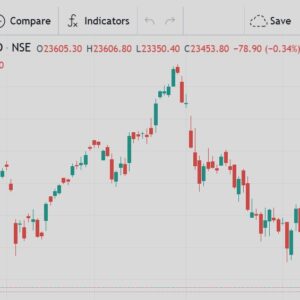Comprehensive Analysis of the Recent Bullish Trends in the Indian Market

The Indian stock market has recently witnessed a strong bullish trend, reflecting renewed confidence among investors and a promising economic outlook. This upward momentum has captured the attention of domestic and global investors, offering significant opportunities for wealth creation and portfolio growth. In this comprehensive analysis, we will delve into the driving factors behind this bullish phase, examine sector-specific performance, and provide insights into what investors might expect moving forward.
1. Factors Fueling the Bullish Trend in the Indian Market
Robust Economic Growth
India’s strong GDP growth is one of the foremost drivers of the current bullish trend. The government’s focus on infrastructure development, digital transformation, and increased foreign direct investment (FDI) has strengthened India’s economic position, leading to higher growth rates and increased investor confidence. With India’s GDP projected to grow steadily in the coming years, the outlook for corporate earnings and stock market performance remains optimistic.
Foreign Institutional Investment (FII) Inflows
The Indian stock market has benefited from substantial inflows from Foreign Institutional Investors (FIIs). As developed economies face challenges such as slowing growth and high inflation, India’s relative economic stability has made it an attractive investment destination. FIIs have shown a strong preference for Indian equities, particularly in sectors like IT, banking, and consumer goods, contributing to the bullish momentum.
Supportive Government Policies
The Indian government has introduced a series of reform-oriented policies that have bolstered the stock market. Measures such as the Production Linked Incentive (PLI) scheme, tax incentives for manufacturing, and initiatives to promote “Atmanirbhar Bharat” (self-reliant India) have provided a strong foundation for sustained economic growth. These initiatives have spurred activity in key sectors like manufacturing, technology, and renewable energy, creating optimism in the markets.
Rising Consumer Demand
As India’s middle class continues to grow, so does consumer spending, particularly in areas such as retail, automotive, real estate, and technology. Increased disposable income, rising urbanization, and a preference for quality goods and services have fueled demand, leading to robust growth in several key industries. This growth in consumer demand has directly impacted corporate revenues, driving stock prices higher.
Stable Interest Rates
Unlike many developed economies that are grappling with high interest rates, the Reserve Bank of India (RBI) has maintained relatively stable interest rates. This has allowed businesses to access affordable capital, supporting expansion and innovation across various sectors. Additionally, stable rates have encouraged investors to seek higher returns in equities, further contributing to the bullish trend.
2. Sector-Specific Performance in the Bullish Market
Information Technology (IT)
The Indian IT sector has been one of the top performers, benefitting from global demand for digital transformation services, software development, and IT consulting. Companies in this sector have capitalized on the digital shift across industries worldwide, with large-cap firms and niche players alike reporting impressive growth in revenues and earnings. With continued advancements in cloud computing, artificial intelligence, and data analytics, the IT sector remains poised for sustained growth.
Banking and Financial Services
The banking and financial services sector has shown remarkable resilience and growth, largely due to robust lending practices, improved asset quality, and digital innovation. Major banks in India have reduced their non-performing assets (NPAs) significantly, restoring investor confidence. Moreover, the adoption of digital banking and fintech has increased profitability and reach within the sector, making it a key contributor to the bullish trend.
Consumer Goods and FMCG
The Fast-Moving Consumer Goods (FMCG) sector has experienced steady growth, driven by rising consumer demand, increased spending on health and wellness, and expanding rural markets. Leading companies in the sector have reported strong sales and profit growth, underpinned by product innovation, e-commerce adoption, and distribution expansion. With consumer preferences continuing to evolve, this sector is likely to sustain its upward trajectory.
Automobile Industry
The automobile sector in India is experiencing a recovery, spurred by rising demand for electric vehicles (EVs), government incentives for sustainable mobility, and improving consumer sentiment. Major automakers have ramped up production to meet demand, particularly in the EV segment. Additionally, the government’s support for eco-friendly vehicles has helped position India as a hub for electric vehicle manufacturing, attracting investments and enhancing the sector’s growth potential.
Pharmaceuticals and Healthcare
India’s pharmaceutical and healthcare sectors continue to draw interest from investors due to rising domestic demand, global exports, and the country’s role as a major supplier of generic drugs. The emphasis on healthcare infrastructure, medical research, and the production of cost-effective medicines has supported the sector’s growth. Moreover, the COVID-19 pandemic underscored the importance of healthcare resilience, driving investment and innovation within the sector.
3. Key Economic Indicators Reinforcing the Bullish Sentiment
Rising Purchasing Managers’ Index (PMI)
A significant indicator of economic health, India’s Manufacturing and Services PMI has consistently shown growth, reflecting strong business activity. A high PMI suggests that businesses are optimistic about future demand, leading to increased production and employment. These factors collectively reinforce the market’s bullish trend, as businesses ramp up to meet consumer demand.
Low Unemployment Rates
India has managed to keep its unemployment rate relatively low, particularly compared to other emerging markets. The creation of jobs in sectors like IT, manufacturing, and retail has helped stabilize household income and fuel consumer spending. Low unemployment rates indicate a healthy labor market, which in turn supports economic growth and boosts market sentiment.
High Foreign Exchange Reserves
India’s robust foreign exchange reserves act as a buffer against currency volatility and external shocks, enhancing investor confidence. A high level of reserves strengthens the country’s economic position and makes it resilient to external factors like fluctuating oil prices and global currency trends. This stability encourages long-term investment, contributing to the bullish trend in the stock market.
4. Future Outlook for the Indian Market
Strong Growth Prospects in Emerging Sectors
India is set to emerge as a global leader in sectors like renewable energy, digital technology, and sustainable manufacturing. The government’s focus on green energy initiatives, such as the National Solar Mission, and investment in electric mobility has attracted foreign investors interested in sustainable projects. These emerging sectors are expected to drive long-term growth, making the Indian market increasingly attractive.
Increasing Role of Retail Investors
A notable trend in the Indian market is the rising participation of retail investors. With increased access to digital trading platforms and financial literacy, individual investors are now more engaged in equity markets than ever before. This influx of retail investors has added liquidity and helped stabilize the market, creating a strong foundation for future growth.
Continued Focus on Infrastructure Development
The Indian government has committed to significant infrastructure investments as part of its economic development agenda. Projects related to transportation, energy, and urban development are expected to drive job creation, improve connectivity, and boost industrial growth. This emphasis on infrastructure serves as a catalyst for long-term economic progress and strengthens the bullish outlook for the market.
Potential Risks and Challenges
While the outlook for the Indian market is optimistic, certain risks remain. Global economic slowdown, potential trade conflicts, and rising inflation in some sectors could pose challenges. Investors should also remain cautious of any fluctuations in foreign exchange rates and unforeseen disruptions in global supply chains. Staying informed about these potential risks will be essential for making sound investment decisions.
5. Strategies for Investors in a Bullish Market
Diversification Across Key Sectors
Investors should consider diversifying their portfolios across sectors that have demonstrated resilience and growth potential, such as IT, banking, and consumer goods. By spreading investments across these areas, investors can mitigate risk while capitalizing on sector-specific opportunities in a growing market.
Focus on High-Quality Stocks
In a bullish market, high-quality stocks with strong fundamentals are likely to perform well. Investors are encouraged to focus on blue-chip companies and emerging leaders in growth sectors like renewable energy and healthcare. Conducting thorough research on company earnings, management quality, and market position can help investors identify promising stocks.
Long-Term Investment Approach
Given India’s growth potential, a long-term investment strategy is advisable for maximizing returns. Investors should focus on holding high-quality stocks for extended periods, allowing them to benefit from market appreciation and compounding returns. This approach is particularly effective in sectors with robust growth prospects, such as technology and pharmaceuticals.
Monitoring Global Economic Trends
Investors should stay informed about global economic trends, as they can influence market sentiment and currency stability. Tracking developments in major economies and geopolitical factors can provide valuable insights into potential market shifts. This awareness allows investors to make timely adjustments to their portfolios to protect against downside risks.
Conclusion: Riding the Wave of Bullish Momentum
The recent bullish trends in the Indian stock market reflect a combination of economic resilience, supportive government policies, and strong corporate performance. As the country continues to grow and diversify its economy, investors have a unique opportunity to participate in a promising market with substantial upside potential. By adopting a strategic, well-informed approach, investors can navigate the market confidently and maximize their returns









